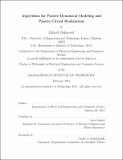Algorithms for passive dynamical modeling and passive circuit realizations
Author(s)
Mahmood, Zohaib
DownloadFull printable version (7.871Mb)
Other Contributors
Massachusetts Institute of Technology. Department of Electrical Engineering and Computer Science.
Advisor
Luca Daniel.
Terms of use
Metadata
Show full item recordAbstract
The design of modern electronic systems is based on extensive numerical simulations, aimed at predicting the overall system performance and compliance since early design stages. Such simulations rely on accurate dynamical models. Linear passive components are described by their frequency response in the form of admittance, impedance or scattering parameters which are obtained by physical measurements or electromagnetic field simulations. Numerical dynamical models for these components are constructed by a fitting to frequency response samples. In order to guarantee stable system level simulations, the dynamical models of the passive components need to preserve the passivity property (or inability to generate power), in addition to being causal and stable. A direct formulation results into a non-convex nonlinear optimization problem which is difficult to solve. In this thesis, we propose multiple algorithms that fit linear passive multiport dynamical models to given frequency response samples. The algorithms are based on convex relaxations of the original non-convex problem. The proposed techniques improve accuracy and computational complexity compared to the existing approaches. Compared to sub-optimal schemes based on singular value or Hamiltonian eigenvalue perturbation, we are able to guarantee convergence to the optimal solution within the given relaxation. Compared to convex formulations based on direct Bounded-Real (or Positive-Real) Lemma constraints, we are able to reduce both memory and time requirements by orders of magnitude. We show how these models can be extended to include geometrical and design parameters. We have applied our passive modeling algorithms and developed new strategies to realize passive multiport circuits to decouple multichannel radio frequency (RF) arrays, specifically for magnetic resonance imaging (MRI) applications. In a coupled parallel transmit array, because of the coupling, the power delivered to a channel is partially distributed to other channels and is dissipated in the circulators. This dissipated power causes a significant reduction in the power efficiency of the overall system. In this work, we propose an automated eigen-decomposition based approach to designing a passive decoupling matrix interfaced between the RF amplifiers and the coils. The decoupling matrix, implemented via hybrid couplers and reactive elements, is optimized to ensure that all forward power is delivered to the load. The results show that our decoupling matrix achieves nearly ideal decoupling. The methods presented in this work scale to any arbitrary number of channels and can be readily applied to other coupled systems such as antenna arrays.
Description
Thesis: Ph. D., Massachusetts Institute of Technology, Department of Electrical Engineering and Computer Science, 2015. This electronic version was submitted by the student author. The certified thesis is available in the Institute Archives and Special Collections. Cataloged from student-submitted PDF version of thesis. Includes bibliographical references (pages 163-174).
Date issued
2015Department
Massachusetts Institute of Technology. Department of Electrical Engineering and Computer SciencePublisher
Massachusetts Institute of Technology
Keywords
Electrical Engineering and Computer Science.